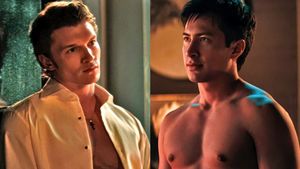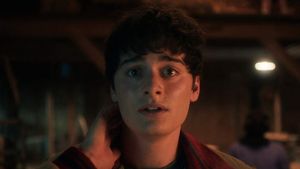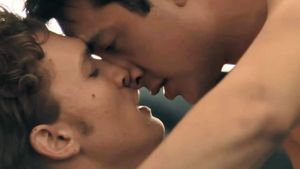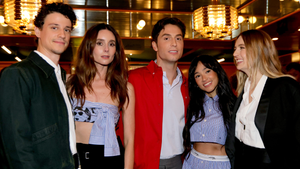On my first day at art school, I saw people with pink hair and piercings. Fresh from a small town in the South, I was in for a culture shock. The year was 2010. I was a farm boy suddenly in class with novice fashion designers and makeup artists from all over the world. So, naturally, it wasn’t long before I woke up with pink hair and facial piercings. I converted.
From the get-go, I was interested in the school's LGBT support group, which I later found out is one of the largest college GSAs (gay-straight alliances) in the Southeast. I attended regularly and soon voiced my interest in holding an officer's position. I thought treasurer would be a good fit. Or secretary.
But in a surprise vote, I was elected president. This was a group with over 500 members on its Facebook group (our largest physical numbers at meetings exceeded 250). It was my second year of college and I was ecstatic about the social points this title would give me with the other gay guys on campus, who I was trying so hard to impress.
But looking over the group on my first night moderating a meeting, I realized the job would be more than that. The clear majority of attendees—most of whom I had never spoken to before—were women, female-presenting, or transgender. I was suddenly in the hot seat and expected to answer these people's questions, give them support, and—most important—memorize their names and pronouns.
Meetings typically began with “group support,” where anyone could raise their hand and talk about problems they had faced during the week or any development in their life. This was followed by group discussion around a central topic (“LGBT and Religion,” “Intersectionality,” “Bisexual Erasure,” etc.) At the time, I felt I was well-versed in all things pertaining to gay men (Grindr! Condoms!) but knew very little about the other letters in the LGBTQA acronym. I felt incredibly illsuited for the job.
Thankfully there was someone there to help. New members were instantly bombarded with a host of unfamiliar terms, and few had the bravery to raise a hand and ask, “What does pansexual mean?” To their salvation as well as mine, there was one member who always stopped the conversation and said, “Hey, does everyone know what pansexual means?”
As if on cue, several heads shook, and she cleared her throat and explained. This was Katie (all names in this article have been changed), a doe-eyed and curvaceous beauty who identified as cisgender and queer, who laughed loudly and began her stories with, “So I was sitting on the toilet one time….”
Katie always seemed keenly aware that all the terminology was a bit overwhelming and something we tended to be oversensitive about. She reminded the group that no one was at fault for not knowing the difference between “tranny” and “transgender," they just needed to be told (although, now, everyone should be pretty aware as it's such a different time). I never told Katie how much she helped me during my early days as president. I would defer to her because she was the “terminology expert”—and because I secretly didn’t know.
Whenever something happened in the news—whenever some new bigot made horrible statements about LGBT or proposed some new antigay law, whenever an LGBT teen committed suicide—a handful of 200 college-aged queers gathered in a commons room at a dormintory and talked about it. If anything, this highlighted the cruelty of the hate people spouted, because this group was where it hit hardest: we were kids, overwhelmed enough with our sexual and gender identities without seeing the ugliest forms of bigotry and homophobia splashed across the news. To this day, when I see people like Mike Huckabee and Kim Davis filling up our televison screens and Facebook feeds, I remind myself that nervous, closeted, beginner LGBT kids are also seeing them, and it fills me with fury.
We saw good things happen too. One by one, we watched as state after state established marriage equality, never for a moment thinking that we were only a few years away from marriage rights nationwide. At the beginning of my presidency, that idea seemed preposterous. We were in the Southeast: surely, we thought, marriage equality would never come here.
Over the course of three years, we watched the nation change. Every Thursday night, someone would do a presentation on asexuality or sexual fluidity. Because of the population of the group, the conversation nearly always spilled into women's rights, gender equality, Planned Parenthood, transgender services, etc. Some kids were catching up on homework, some sat in the back, terrified to speak. Almost every night, someone told the group they were planning to come out to their families during the next school break, and they were scared.
A couple kids were kicked out of their homes after coming out, and left the school for cheaper education elsewhere. Some kids reported wonderful coming out stories. Many of us—including me—had difficult lives at home with parents that didn’t approve. When religious bigots spouted hate, we saw in them our parents and churches we had looked forward to leaving. In a group setting, it was easy to roast homophobes and mock their religion.
But one transgender member, Daniel, always had the boldness to speak up. Daniel was a Christian, and at the most important times he would quietly and firmly remind everyone that not all Christians were the angry and intolerant kind we were seeing on TV. I would later learn that many new members came up to Daniel after meetings to tell him thank you. In a group that celebrated inclusion, no one should have felt ostracized for their beliefs, but there were definitely some nights we came close to turning away religious members who needed a support group. Daniel kept us in check.
One member started a second group called “Gender Equality Now,” which regularly pushed for gender-neutral housing at the college (which still hasn’t been implemented). Another member, a black young woman who spoke often about the intersection of racial and sexual minorities, was involved in several other clubs—the performing arts club, and animation club, the writer’s club—and was the key liaison between them.
One member I was most inspired by—a shy, handsome, blue-eyed gay guy who appearing in meetings during my third year—saw that the school had no Relay For Life event. Relay for Life is an international fundraising event started by the American Cancer Society that typically happens once a year to fight cancer. Through fundraising efforts and letters to the administration, he single-handedly started a club, raised funds, and organized the school's first relay. And he did it again the next year, when it became the highest-attended event on campus. Today it is still going strong.
One member came in every meeting, sit in the middle of the room, and as soon as support time began, her hand was up. She was transgender and often shared her story of dealing with depression. When called upon, she would begin a story that lasted the entire discussion period and nearly always ended with her in tears. It put the board of officers in a tough place: on the one hand, this member needed a space where people would listen. On the other hand, she was taking time away from others.
Eventually we realized that our “support group” model was not foolproof. When giving support, there comes a point at which you can become someone’s crutch. Over the course of my presidency I met many people who had very little confidence—they were just beginning to understand their sexuality or gender identity, and felt very overwhelmed and uncertain—and they would constantly want to talk. They were getting their emotional "build-up" from others when they needed to be able to find it in themselves. We realized that there comes a point in which you can enable a cycle of dependency that doesn’t help. Eventually we had to recommend she see a counselor with the school—someone trained to do what none of us had been trained to do—and we started limiting the time that people could talk in meetings.
I'm happy to report that as my time as president drew to its close, she returned to meetings looking happier than ever. Hers was a tough story; she was ex-military and had been estranged from her family. One night when I drove her home from a meeting, she told me something I will never forget: "I think that some people who look at the group from the outside think it's kind of dumb. But they have no idea how important it is."
The lessons I took from three years of moderating meetings and organizing campus-wide events and fundraisers were the most impactful of my life. For three years, the majority of members continued to be people whose identities were on the fringe of LGBTQ. College-aged gay men, it seemed, didn’t need a support group. I would later understand and appreciate the fact that our fraternizing tends to happen in the bar or in bed. In group meetings, the smallest population present was always gay-identified men. Many guys I talked to outside the group said they had gone to a couple meetings but couldn’t connect to the stories told there—stories from members who were genderqueer, pansexual, and sexually fluid—so they lost interest.
It eventually seemed like college gay men—and perhaps gay men in general—didn’t connect well to others on the queer spectrum. At least in the microcosm of LGBT that the group offered, the people who found the most strength and solidarity in each other’s experiences were the ones who fell outside the hard, longstanding identities of “gay” and “lesbian.” The queer women whose sexualities and gender identities tended to the fluid were the most active and consistent members. They organized clothing swaps for trans members and held weekly study groups at queer-friendly coffee shops. They did what I could not: they created an unshakeable sense of group identity.
After three years, a transformation had taken place: these hard distinctions—the distinction of myself as “gay” and “male” and the way these identities differed from most people in the group—completely broke down and became irrelevant. During the annual 'ThanksGAYving' potluck dinner we had before winter break of my final year, I realized that I no longer saw myself as different from anyone in the group. We were all on a spectrum. “This is how LGBT should be,” I thought. “This is what we are capable of.”
On my last night as president, I was hugged by dozens of people. One of them was a young genderqueer woman with sandy blonde hair and freckles, who had quietly sat in the back for most of my run. She hugged me and said, “I’ve always admired you and I'm going to miss you so much. This group will never be the same.” Now, every Thursday that passes, I picture them gathered in the common room. For some kids, it will be the first safe space they have ever known.
Alex Cheves was the Advocate intern and a contributor to SheWired during his tenure.























































































